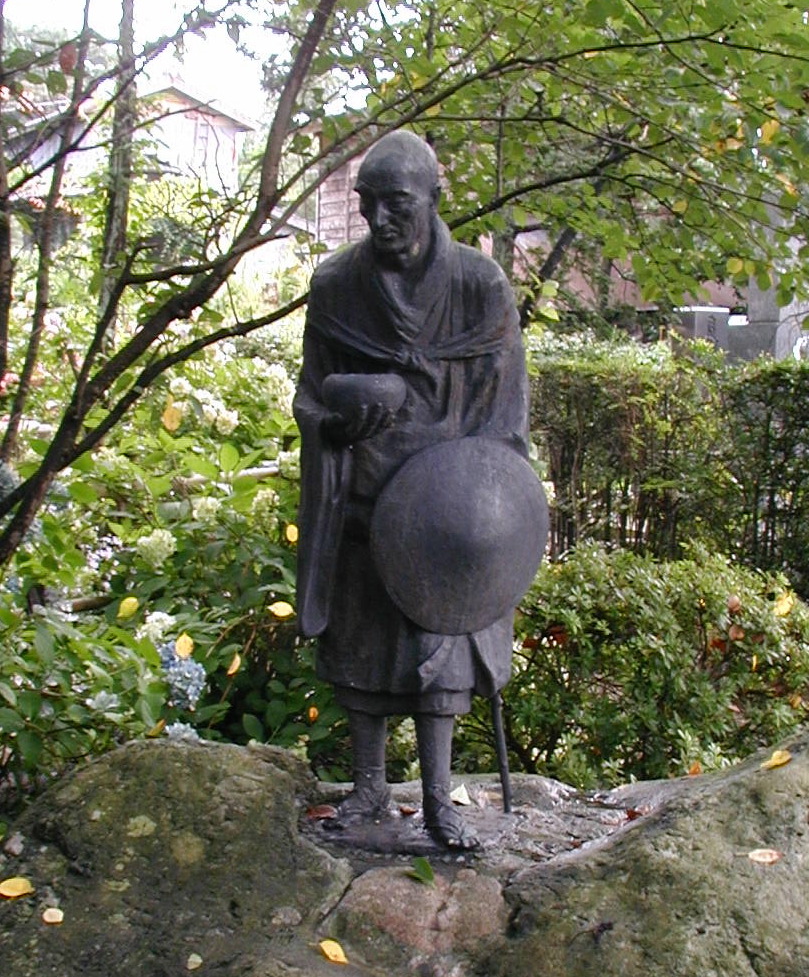- Ryōkan
Infobox Buddhist biography
name = Ryōkan

img_size =
img_capt = A statue of Ryōkan.
landscape =
birth_name =
other_names =
dharma_name =
birth_date = 1758
birth_place =Niigata Prefecture ,Japan
death_date = 1831
death_place =
nationality =
denomination =
school =Soto
lineage =
title =Roshi
workplace =
education =
occupation =
teacher =
reincarnation_of =
predecessor =
successor =
student =
spouse =
partner =
children =
website = nihongo|Ryōkan Taigu|良寛| (1758–1831) was a quiet and eccentricSōtō Zen Buddhist monk who lived much of his life as ahermit . Ryōkan is remembered for hispoetry andcalligraphy , which present the essence of Zen life.Early life
Ryōkan was born in the village of Izumozaki in Echigo Province (now
Niigata Prefecture ) inJapan to the village headman. He renounced the world at an early age to train at nearby Sōtō Zen templeKōshōji , refusing to meet with or accept charity from his family. Once the Zen masterKokusen visited the temple, and Ryōkan was deeply impressed with his demeanor. He solicited permission to become Kokusen's disciple. Kokusen accepted, and the two returned toEntsūji monastery in Tamashima (nowOkayama Prefecture ).It was at Entsūji that Ryōkan attained
satori and was presented with anInka by Kosusen. Kokusen died the following year, and Ryōkan left Entsūji to embark on a long pilgrimage. He lived much of the rest of his life as ahermit , and did not return to monastic life.He was originally ordained as Ryōkan Taigu. "Ryō" means "good"; "kan" is "broad" and "Taigu" is "great fool", so that "Ryōkan" is like broad-hearted and generous. These are all qualities that Ryōkan's work embodies.
Life as a hermit
Ryōkan spent much of his time writing
poetry ,calligraphy , and communing with nature. His poetry is often very simple and inspired by nature. He loved children, and sometimes forgot to beg for food because he was playing with the children of the nearby village. Ryōkan refused to accept any position as a priest or even as a "poet", which shows his great humility. In the tradition of Zen his quotes and poems show he had a good sense of humour and didn't take himself too seriously. However his poetry also gives illumining insights into the practise of Zen.Ryōkan lived a very simple, pure life, and stories about his kindness and generosity abound. On his deathbed, Ryōkan offered the following
death poem to Teishin his close companion::裏を見せ 表を見せて 散る紅葉:うらを見せ おもてを見せて 散るもみじ :"ura wo mise / omote wo misete / chiru
momiji ":"showing their backs / then their fronts / falling maple leafs"However, even though he lived his simple and pure life, he also displayed characteristics that under normal circumstances would be out of line for a normal monk.
tories of Ryokan
It is common practice for a monk to abstain from eating meat. Once a young monk sat to dinner with Ryokan and watched him eat fish. When asked why, Ryokan replied, “I eat fish when it’s offered, but I also let the fleas and flies feast on me [when sleeping at night] . Neither bothers me at all.”
It is said Ryokan only slept with most of his body inside of a mosquito net so that he would not hurt the bugs outside.
Ryokan attended the midsummer Bon Festivals. Because he was a monk, he would normally be unable to attend, but sneaked in disguised as a woman.
Ryokan hated waste, and so any food that he was offered that he did not eat, he put into a little pot. Over time, the food rotted and became filled with maggots and other bugs. When warned against eating it, all Ryokan said was, “No, no, it’s all right. I let the maggots escape before I eat it and it tastes just fine!”
Further reading
*"One Robe, One Bowl; The Zen Poetry of Ryōkan" (ISBN 0834801264), 1977, translated and introduced by John Stevens.
*"Three Zen Masters: Ikkyū, Hakuin, Ryōkan (Kodansha Biographies)" (ISBN 4770016514), 1993, by John Stevens.
*"The Zen Fool: Ryōkan" (ISBN 0804821283), 2000, byMisao Kodama andHikosaku Yanagashima .
*"Great Fool: Zen Master Ryōkan: Poems, Letters, and Other Writings" (ISBN 082481777X), 1996, byRyuichi Abe (with Peter Haskel).
*"Ryokan: Selected Tanka and Haiku", translated from the Japanese by Sanford Goldstein, Shigeo Mizoguchi and Fujisato Kitajima (Kokodo, 2000)
*"Ryokan's Calligraphy", by Kiichi Kato; translated by Sanford Goldstein and Fujisato Kitajima (Kokodo, 1997)External links
* [http://www.tamucc.edu/~sencerz/ryokan.htm Ryōkan's poetry]
* [http://www.hermitary.com/articles/ryokan.html Ryōkan as hermit]
* [http://www.metmuseum.org/special/Written_Image/54.r.htm Calligraphy]
* [http://www.poetseers.org/spiritual_and_devotional_poets/buddhist/ryokan/ Poems by Ryōkan]
* [http://oldpoetry.com/oauthor/show/Taigu_Ryokan/ Ryōkan's poetry]
Wikimedia Foundation. 2010.
